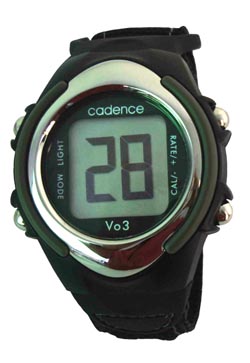
In 2002, Vanja Buvac choose a path that would affect the next seven years of his life.
To create a product he had envisioned as an amateur rower in Cambridge, Massachusetts, he would have to become an engineer to design it or a patent attorney to protect it.
Buvac wanted to make it easier for rowers to track performance and saw an opportunity to create a portable device that could record stroke rate, unlike traditional in-cockpit stroke counters. He had a simple solution: incorporate the technology into a wristwatch. Rowers could wear it as a status symbol or strap the timepiece directly onto an oar.
“I thought, ‘do I hire an engineer to help me concoct this thing, or a patent attorney to help me patent it,” the tall, thin entrepreneur says, seated on a couch in his East Arch Street office, overlooking a spacial view of Center City. “I looked at the price of both. Engineers I could get for $40 an hour, patent attorneys were $300. So I said ‘alright, I better learn patent law instead of engineering,’ he says, laughing.
Cadence Rowing was born.

Out of the experience, Buvac would eventually become both engineer and patent expert, skills that would lead to a position with University City-based Neat Company managing the software company’s patent portfolio.
He also found himself in prominent roles throughout Philadelphia’s technology community. Buvac has a place throughout Technically Philly’s archives, often in background, quietly helping organizations like The Hacktory, Ignite Philly, Make:Philly and Nonprofit Technology Resources. During the past year, Buvac has dialed back his roles to focus on Cadence.
It’s paid off. The company is in the process of moving away from direct sales and has gained 21 distributors worldwide. Because there’s only about 250,000 rowers in the market, Buvac sees rowing as a stepping stone to other ambitious markets in 2010. The sales from the rowing side are enabling him to fuel the expansion, he says.
THE CONCEPT
Buvac sold his first batch of rower’s watches only a few months after literally soldering together a prototype in his and his wife’s kitchen in 2002. He knew the product had potential. It was cheaper to design and easier to transport than traditional performance tracking systems. Others thought so, too.
In 2004, sporting instrument manufacturer and Boothwyn-based Nielsen Kellerman agreed to license the patent for four years. Nielson produced a wrist watch that utilized the technology until 2008, but the manufacturer missed the market, Buvac says.
“They’re an excellent company – they do all of their manufacturing in the U.S. My product, made in China, was a bit of an oddball for them,” Buvac says. “Their main focus was promoting the stuff that was made in their factory because they have all the manufacturing overhead that they have to support.”
ITS NEWEST INCARNATION AND BEYOND

Buvac took the patent back after Nielson missed the sales requirement to renew the patent, and he decided to start producing and marketing his own watch in early 2009.
He brought the design back to the device’s original prototype on the behest of customers who liked large, viewable digits that they could see from afar and designed the Vo3 [pictured above], a strict rowing apparatus.
Further responding to customer requests, Buvac began designing the Vo4, which features a stroke rate counter, timepiece, stop watch and alarm; everything you’d expect from a normal watch. He’s also working on the Vo5, which includes a heart rate monitor so rowers can get even more detail about their workout. Buvac hopes to ship it before the holiday season.
The future? Similar performance models for kayakers, swimmers and other athletes and a move to aesthetic luxury markets.
Buvac says that consumers purchase Cadence watches for two reasons: performance enhancement, first. But a second tier of customers buy the timepieces as status symbols. “They want to show off that they are rowers and this is the rower’s watch,” he says.
In April, just before post-secondary graduations throughout the U.S., Buvac began marketing the Oarsman, a luxury analog piece. The watch’s most notable function is that it lets user measure the stroke rate of a passing crew.
“You’re watching a passing boat. They take one stroke,” he says, clicking a button to start the chronograph. “Next stroke,” he says, stopping the counter. The dial then displays how much time it took between the two strokes. It sold well enough that the company also began designing a women’s model with pink accents and feminine design.
THE TECHNOLOGY

Buvac demonstrates Cadence’s flagship model, the Vo3, flipping it back and forth like a rower would, as the per-minute stroke rate consistently recalculates on the screen.
When he first came up with the idea for a rowing watch, he says he hadn’t a clue about how to create the technology for it to happen.
“I went to Radio Shack and asked the guy, ‘hey, I need [a part] that’s going to count something,’ and the guy says, ‘sounds like you need a micro-controller,” Buvac says. “I was like, wow!,” his brown eyes lighting up behind wirey, gold glasses.
But it was his childhood that helped put him in a position to design the product himself.
Growing up in Zagreb, now the largest city in Croatia but then in former Yugoslovia in the mid-1980s, Buvac spent his days creating games and hacking the Commodore 64’s 6502 processor, a basic system with a limited-language programming syntax. He learned from a young age how to do creative things with limited resources. Switching to the micro-controller environment found in Cadence’s watches was familiar to him.
Inside the Vo3, after opening the device’s black plastic casing, a printed circuit board is sandwiched inside. On the board, a crystal controls the time, and the micro-controller is bonded onto the board along with the heart of the watch, a small gold-colored tilt-switch that measures stroke rate.
The tilt-switch is a simple component. When a small ball inside it touches an electrode on one end of the switch, it closes the contact between the gold-colored can and the electrode. The switch counts from open-circuit to open-circuit. When the ball loses contact with the electrode, an algorithm then calculates how many strokes-per-minute a rower is making.
Buvac has moved away from being involved with the technology of the product, he regrets, because business has begun taking up so much of his time.
“[The watch market] is a perfect combination of technology and aesthetics for my liking. There’s a lot of tech stuff in there, but on the other hand, you’re not wearing a watch to tell time, you’re wearing a watch to tell people something about yourself.”
Buvac traveled to China to work directly with manufacturers to design the watch, choosing from thousands of general designs and then customizing it for Cadence’s purposes.
“It’s amazing how well-segmented the whole watch market is. The strap is made by one factory, a case is made by another, buttons by a third. You have ten or 15 suppliers for this one watch.”
It’s a competitive market, Buvac says, with several main manufacturers doing a majority of business and 150 to 200 small watchmakers, like Cadence, that target smaller niches.
Cadence is the only one that is making watches for rowers and Buvac says that aligning himself with an elite sport is advantageous to the business, too. It certainly doesn’t hurt that he’s in Philadelphia, a popular rowing town, home to historic Boathouse Row.
“[Philly] is a big rowing community, but the size of the market doesn’t really allow itself for that much innovation,” Buvac says.
That puts him in a unique position, in both the rowing community and Philadelphia’s technology community, two markets that could potentially learn a lot from one another.
Every Wednesday,Shop Talk shows you what goes into a tech product, organization or business in the Philadelphia region. See others here.






